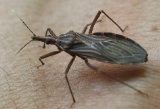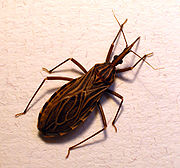
Rhodnius
Encyclopedia
Rhodnius is a genus
of bugs
in the subfamily Triatominae
, important vectors of Chagas disease
. They were important models for Sir Vincent Wigglesworth's
studies of insect physiology, specifically growth and development.

Species marked with (Tc) are associated with Trypanosoma cruzi
Genus
In biology, a genus is a low-level taxonomic rank used in the biological classification of living and fossil organisms, which is an example of definition by genus and differentia...
of bugs
Hemiptera
Hemiptera is an order of insects most often known as the true bugs , comprising around 50,000–80,000 species of cicadas, aphids, planthoppers, leafhoppers, shield bugs, and others...
in the subfamily Triatominae
Triatominae
The members of Triatominae , a subfamily of Reduviidae, are also known as conenose bugs, kissing bugs, assassin bugs or triatomines. Most of the 130 or more species of this subfamily are haematophagous, i.e. feed on vertebrate blood; a very few species feed on other invertebrates...
, important vectors of Chagas disease
Chagas disease
Chagas disease is a tropical parasitic disease caused by the flagellate protozoan Trypanosoma cruzi. T. cruzi is commonly transmitted to humans and other mammals by an insect vector, the blood-sucking insects of the subfamily Triatominae most commonly species belonging to the Triatoma, Rhodnius,...
. They were important models for Sir Vincent Wigglesworth's
Vincent Wigglesworth
Sir Vincent Brian Wigglesworth FRS was a British entomologist who made significant contributions to the field of insect physiology.In particular, he studied metamorphosis...
studies of insect physiology, specifically growth and development.
Species
- Rhodnius amazonicus Almeida, Santos & Sposina, 1973
- Rhodnius brethesi Matta, 1919 (Tc)
- Rhodnius colombiensis Moreno Mejía, Galvão & Jurberg, 1999.
- Rhodnius dalessandroi Carcavallo & Barreto, 1976
- Rhodnius domesticus Neiva & Pinto, 1923 (Tc)
- Rhodnius ecuadoriensis Lent & León, 1958 (Tc)
- Rhodnius milesi Carcavallo, Rocha, Galvão, Jurberg (in: Valente et al., 2001)
- Rhodnius nasutusRhodnius nasutusRhodnius nasutus is a Chagas disease vector native to the northeast of Brazil. It is primarily associated with the Copernicia prunifera palm tree . In 2006 and 2007, the species was documented to use Licania rigida trees in suburban areas of Jaguaruana, Ceará....
Stal, 1859 (Tc) - Rhodnius neglectus Lent, 1954 (Tc)
- Rhodnius neivai Lent, 1953
- Rhodnius pallescens Barber, 1932 (Tc) (principal vector in PanamaPanamaPanama , officially the Republic of Panama , is the southernmost country of Central America. Situated on the isthmus connecting North and South America, it is bordered by Costa Rica to the northwest, Colombia to the southeast, the Caribbean Sea to the north and the Pacific Ocean to the south. The...
). - Rhodnius paraensis Sherlock, Guitton & Miles, 1977 (Tc)
- Rhodnius pictipes Stal, 1872 (Tc)

- Rhodnius prolixusRhodnius prolixusRhodnius prolixus is the second most important triatomine vector of the Chagas parasite due to its efficient adaptation to the human domicile in northern South America, where sylvatic populations also exist, and in Central America where it is exclusively domestic...
Stal, 1859 (Tc) (principal vector in ColombiaColombiaColombia, officially the Republic of Colombia , is a unitary constitutional republic comprising thirty-two departments. The country is located in northwestern South America, bordered to the east by Venezuela and Brazil; to the south by Ecuador and Peru; to the north by the Caribbean Sea; to the...
and VenezuelaVenezuelaVenezuela , officially called the Bolivarian Republic of Venezuela , is a tropical country on the northern coast of South America. It borders Colombia to the west, Guyana to the east, and Brazil to the south...
, and in GuatemalaGuatemalaGuatemala is a country in Central America bordered by Mexico to the north and west, the Pacific Ocean to the southwest, Belize to the northeast, the Caribbean to the east, and Honduras and El Salvador to the southeast...
, HondurasHondurasHonduras is a republic in Central America. It was previously known as Spanish Honduras to differentiate it from British Honduras, which became the modern-day state of Belize...
and some parts of NicaraguaNicaraguaNicaragua is the largest country in the Central American American isthmus, bordered by Honduras to the north and Costa Rica to the south. The country is situated between 11 and 14 degrees north of the Equator in the Northern Hemisphere, which places it entirely within the tropics. The Pacific Ocean...
and El SalvadorEl SalvadorEl Salvador or simply Salvador is the smallest and the most densely populated country in Central America. The country's capital city and largest city is San Salvador; Santa Ana and San Miguel are also important cultural and commercial centers in the country and in all of Central America...
). - Rhodnius robustus Larrousse, 1927 (Tc)
- Rhodnius stali Lent, Jurberg & Galvão, 1993 (Tc)
Species marked with (Tc) are associated with Trypanosoma cruzi
Trypanosoma cruzi
Trypanosoma cruzi is a species of parasitic euglenoid trypanosomes. This species causes the trypanosomiasis diseases in humans and animals in America...

